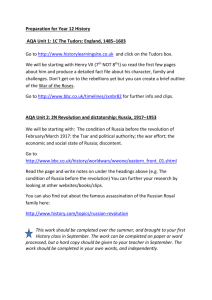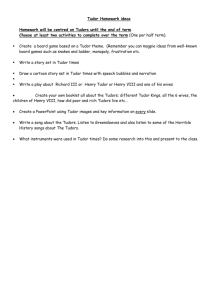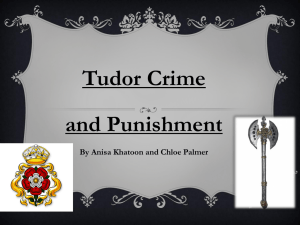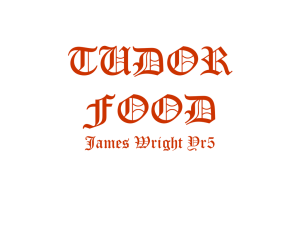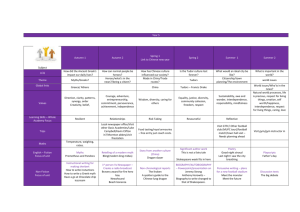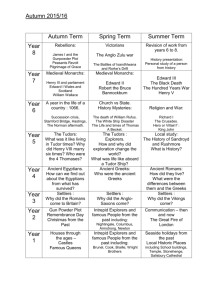The Tudors The Early Tudors King Henry VII 1457 – 1509
advertisement
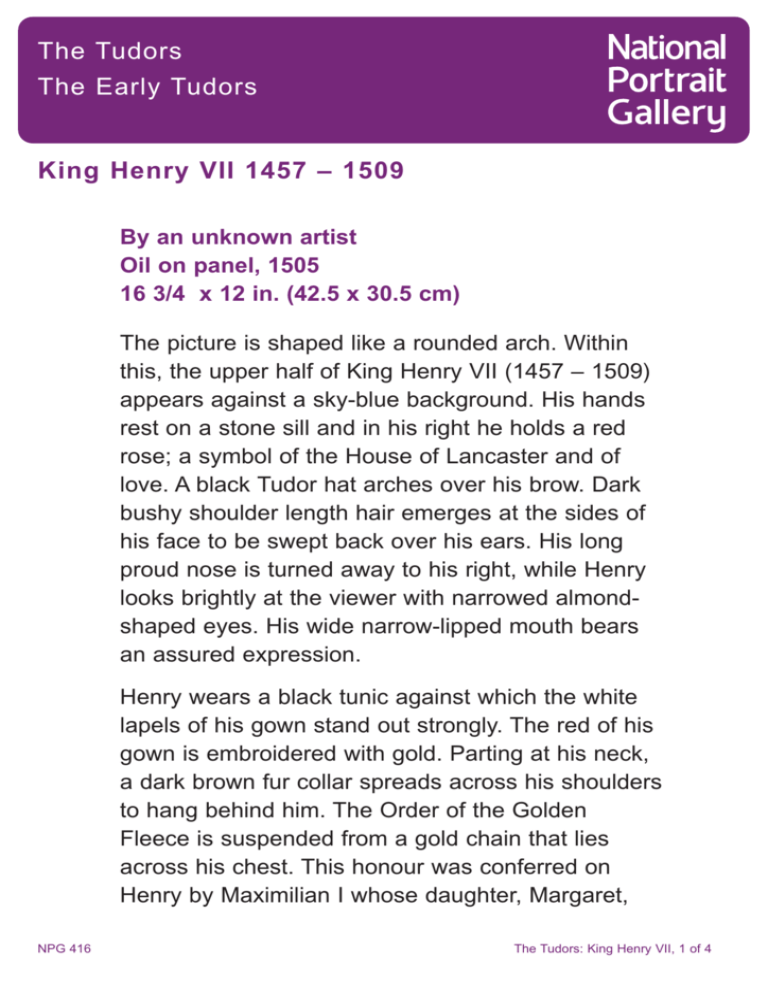
The Tudors The Early Tudors King Henry VII 1457 – 1509 By an unknown artist Oil on panel, 1505 16 3/4 x 12 in. (42.5 x 30.5 cm) The picture is shaped like a rounded arch. Within this, the upper half of King Henry VII (1457 – 1509) appears against a sky-blue background. His hands rest on a stone sill and in his right he holds a red rose; a symbol of the House of Lancaster and of love. A black Tudor hat arches over his brow. Dark bushy shoulder length hair emerges at the sides of his face to be swept back over his ears. His long proud nose is turned away to his right, while Henry looks brightly at the viewer with narrowed almondshaped eyes. His wide narrow-lipped mouth bears an assured expression. Henry wears a black tunic against which the white lapels of his gown stand out strongly. The red of his gown is embroidered with gold. Parting at his neck, a dark brown fur collar spreads across his shoulders to hang behind him. The Order of the Golden Fleece is suspended from a gold chain that lies across his chest. This honour was conferred on Henry by Maximilian I whose daughter, Margaret, NPG 416 The Tudors: King Henry VII, 1 of 4 The Tudors The Early Tudors Henry intended to marry. An inscription on the sill records that the painting was made at the order of Herman Rinck, agent of Maximilian I, on October 29 1505. NPG 416 The Tudors: King Henry VII, 2 of 4 The Tudors The Early Tudors King Henry VII 1457 – 1509 NPG 416 The Tudors: King Henry VII, 3 of 4 The Tudors The Early Tudors King Henry VII 1457 – 1509 NPG 416 The Tudors: King Henry VII, 4 of 4 The Tudors The Early Tudors Elizabeth of York 1465 – 1503 By an unknown artist Oil on panel; a late sixteenth-century copy from a portrait of about 1500 22 1/4 x 16 3/8 in. (56.5 x 41.6 cm) Elizabeth of York (1465 – 1503) stands behind a drapery on which her hands rest, holding the white rose of the house of York. The drapery is embroidered with a pattern of gold foliage on dark grey-green fabric. She wears a crimson longsleeved dress with white silk cuffs. Her face is framed by the narrow opening of a large dark gabled hood. It rises in a triangular arch above her brow so that the parting in her chestnut hair is visible. The opening is decorated with a border of embroidered gold squares that have alternating centres of rubies and emeralds. The long vertical sides conceal part of her cheeks and fall beside the square-cut neck of her crimson dress. Her forehead has an intelligent high dome. Faint plucked brows arch down to her straight nose. Full rosebud lips sit above her little chin. Her left cheek is turned towards you while her almond-shaped eyes look ahead into the distance. A pendant hangs NPG 311 The Tudors: Elizabeth of York, 1 of 4 The Tudors The Early Tudors at her neck combining rubies and pearls in the shape of the Tudor rose. The words ‘Elizabetha Uxor Henrici VII’ (‘Elizabeth wife of Henry VII’) are written across the dark brown background at the top of the painting. NPG 311 The Tudors: Elizabeth of York, 2 of 4 The Tudors The Early Tudors Elizabeth of York 1465 – 1503 NPG 311 The Tudors: Elizabeth of York, 3 of 4 The Tudors The Early Tudors Elizabeth of York 1465 – 1503 NPG 311 The Tudors: Elizabeth of York, 4 of 4 The Tudors The Early Tudors King Henry VIII 1491 – 1547 and King Henry VII 1457 – 1509 By Hans Holbein the Younger (1497 or 8 – 1543) Ink and watercolour on paper, about 1536–1537 101 1/2 x 54 in. (257.8 x 137.2 cm) This is a preparatory line drawing for half of a large wall painting in Whitehall Palace. The paper was made by pasting A4-sized sheets together and has aged to become an uneven light brown colour. It was used as a ‘cartoon’, a design for a mural. A method called ‘pouncing’ was used where lines were pierced with tiny holes, charcoal dust was brushed through and the design then transferred onto the wall. Henry VIII dominates this life-size drawing, standing at the front edge of a loosely carpeted step with his massive stockinged legs broadly spread. His gown opens wide to reveal his broad barrel chest, his fabrics, his jewellery and his proud codpiece. His arms emerge from the gown in the wide puffed sleeves of his jacket. Under a broad feathered bonnet, Henry VIII’s face is enlarged by a full rounded beard and moustache. Within this shape his exquisite narrow eyes and long fine nose are very faint. The overall NPG 4027 The Tudors: King Henry VIII, 1 of 4 The Tudors The Early Tudors effect of his head and body is huge. Behind him steps rise to a shell-like niche beneath a frieze of figures from classical mythology. Overlapping the frieze is the face of Henry VII who stands in the background. Standing on the carpeted top step at the level of his son’s knees, Henry VII’s waist is just above the level of Henry VIII’s left shoulder. Wearing a black soft hat adorned with a Tudor rose, Henry VII holds his ample gown closed at his waist. They both look ahead into the distance on your right. NPG 4027 The Tudors: King Henry VIII, 2 of 4 The Tudors The Early Tudors King Henry VIII 1491 – 1547 and King Henry VII 1457 – 1509 NPG 4027 The Tudors: King Henry VIII, 3 of 4 The Tudors The Early Tudors King Henry VII 1457 – 1509 NPG 4027 The Tudors: King Henry VIII, 4 of 4 The Tudors The Early Tudors King Edward VI 1537–53 By William Scrots (active 1537–53) Oil on panel, 1546 16 3/4 x 63 in. (42.5 x 160 cm) This portrait is a wide-stretched distortion, known as an ‘anamorphic distortion’. The image appears correctly only when viewed from the extreme lefthand side. Ordinarily an image is put on a surface directly facing the artist and is intended to be viewed from about the same position. In order to create this picture the artist painted the image on the painting’s surface while it was tilted away so that the artist’s eye was almost in line with the surface of the picture. It only becomes recognisable when the same position is taken by the viewer. Sometimes shadows make this kind of distortion, just as a setting sun may cast a long shadow from an object. This painting is like a coloured-in shadow which shows the bust of Edward VI, aged nine years, as if his portrait is a coin. The coin hovers above a hilly rural landscape and a far-off city. Edward’s shoulders and bonnet overlap all but the outline of the coin. It is divided NPG 1299 The Tudors: King Edward VI, 1 of 4 The Tudors The Early Tudors by a white line into a dark inner circle and a bronze border. The border ahead of him gives his age; ‘Aetatis suae-9’, ‘His summers-9’. Behind his head is the date; ‘Anno Domini - 1546’, ‘The year of the Lord -1546’. The letter ‘E’ looms large beside his nose. The letter ‘P’ sits in line with it behind his neck. These letters are in Latin and identify the sitter as Prince Edward. The white feather of a black bonnet sits along the top of his head on short red hair. His hairline curves above his round pink cheek to his ear. Edward’s big eye looks directly ahead under a faint eyebrow. His profile shows a little chin and a pointed nose recessed under a round brow. A white lace frill surrounds his neck, and across his chest lie jewelled gold chains. NPG 1299 The Tudors: King Edward VI, 2 of 4 The Tudors The Early Tudors King Edward VI 1537–53 NPG 1299 The Tudors: King Edward VI, 3 of 4 The Tudors The Early Tudors King Edward VI 1537–53 NPG 1299 The Tudors: King Edward VI, 4 of 4 The Tudors The Early Tudors Catherine Parr 1512 – 48 Attributed to Master John (active 1544–5) Oil on panel, about 1545 71 x 37 in. (180.3 x 94 cm) Catherine Parr (1512 – 48) is about two thirds lifesize, she stands on the vermilion and dark blue of a Persian carpet. The square neck of her dress is cut low to reveal the top of her shoulders. Her face, neck and shoulders gleam pale and bright. At her tight waist the triangle of her bodice meets the triangle of her wide underskirt. The geometry of her dress combines with a flat blue background to give an air of simplicity to a portrait opulent with jewels and fabrics. She returns your gaze thoughtfully with dark almondshaped eyes set amidst the soft features of her oval face. Her reddish hair parts under a crimson crescent headpiece with a white jewelled border. At her neck a pendant hangs. Beneath it a large crown-headed brooch is pinned to the dress. It is a dress of cloth-of-silver over a crimson underskirt embroidered with gold and pearls. Bell-shaped fur oversleeves open out from narrow elbows into enormous cuffs. Wide crimson underNPG 4451 The Tudors: Catherine Parr, 1 of 4 The Tudors The Early Tudors sleeves emerge and narrow to her wrists, surrounding them with white silken puffs. Partly concealed by pleated white cuffs, her hands touch, wearing rings of jet. Below her hands pairs of cameo heads hang down to end in a tassel at ankle height. NPG 4451 The Tudors: Catherine Parr, 2 of 4 The Tudors The Early Tudors Catherine Parr 1512 – 48 NPG 4451 The Tudors: Catherine Parr, 3 of 4 The Tudors The Early Tudors Catherine Parr 1512 – 48 NPG 4451 The Tudors: Catherine Parr, 4 of 4 The Tudors The Court of Elizabeth Queen Elizabeth I 1533 – 1603 By an unknown artist; possibly a copy of a coronation portrait of 1559 Oil on panel, about 1600 50 1/8 x 39 1/4 in. (127.3 x 99.7 cm) The young queen stands facing us in her full coronation regalia, fragile and doll-like yet the embodiment of royalty. Against a plain dark blue background she is depicted three-quarter length. Small black eyes stare from the pale oval face with its delicate skin, lightly brushed with red on the cheeks and on the small, determined mouth. She wears a heavy jewelled crown on top of the long golden hair that hangs loose about her shoulders and falls below her waist. Elizabeth’s slender body is encased in a stiffened bodice of cloth of gold and a cloth of gold skirt, both patterned with symbols of royalty, the fleur de lys of France and the Tudor rose. A heavy cloak of the same fabric hangs from her shoulders, its wide ermine collar held in place with long gold cords ending in two large tassels. The cloak is open, to reveal the ermine lining. It falls away over her right arm and follows a sweeping curve NPG 5175 The Tudors: Queen Elizabeth I, 1 of 4 The Tudors The Court of Elizabeth over her left arm and across the body to join the other side of the cloak on the bottom left of the painting. Her opulent jewels are rubies, deep blue sapphires and pearls. Over the cloak round her shoulders, is a heavy jewelled chain and above, round her neck, is a matching choker from which issues a stiff white ruff that hugs the contours of her face, giving the impression that her head grows directly from her clothes with no neck. In her long white fingers the queen holds the symbols of office, the tall jewelled sceptre and the orb, dark blue, encircled with jewels topped with a large blue cross embellished with pearls. She holds the orb firmly with ringed fingers against the gold of her skirt. NPG 5175 The Tudors: Queen Elizabeth I, 2 of 4 The Tudors The Court of Elizabeth Queen Elizabeth I 1533 – 1603 NPG 5175 The Tudors: Queen Elizabeth I, 3 of 4 The Tudors The Court of Elizabeth Queen Elizabeth I 1533 – 1603 NPG 5175 The Tudors: Queen Elizabeth I, 4 of 4 The Tudors The Court of Elizabeth Queen Elizabeth I 1533 – 1603 By Marcus Gheeraerts the Younger (1561 or 2 – 1636) Oil on canvas, about 1592 95 x 60 in. (241.3 x 152.4 cm) Against a sky, stormy with flashing lightning to the right and pale blue with sunlit clouds to the left, Queen Elizabeth I (1533 – 1603) towers above a map of England, her feet in the county of Oxfordshire. England stretches across the curve of the Earth and there are tiny galleons dotted about on a dark bottle green sea. She is turned slightly to her right, resplendent in a pale silvery satin dress. The artist shows a virtuosity in the handling of oil paint especially in the portrayal of light shining on fabrics and jewels. Thin bright white lines on the cooler tones of the costume suggest the shimmering effect of light on satin. Her dark eyes stare out of a powdered white face and her red lips are pursed. She has a high forehead and her hair is set with pearls. Close to her left ear there is a jewel in the form of a celestial sphere and a large red jewel sits on the top of her NPG 2561 The Tudors: Queen Elizabeth I, 1 of 4 The Tudors The Court of Elizabeth crown. Ropes of pears hang down to below her waist. A transparent veil forms two curved winglike shapes at the back of her head and a ruff rising up from the neckline of her bodice is open to reveal an elaborate necklace. In her right hand she holds a fan, attached to the waist by a coral red ribbon. In her left hand there is a pair of gloves. Her bodice tapers to a tiny waist; the skirt spreading out in a wide circle. The costume is intricately decorated with a lattice-work design and rosettes in puffed silk. In the centre of eachrosette there are brilliant rubies, diamonds and pearls in gold settings. Pearls, which were the favourite jewel of the queen, edge her entire costume. The stormy sky, the clouds parting to reveal sunshine, and the Latin inscriptions on the painting make it plain that the portrait’s symbolic theme is forgiveness. NPG 2561 The Tudors: Queen Elizabeth I, 2 of 4 The Tudors The Court of Elizabeth Elizabeth of York 1465 – 1503 NPG 2561 The Tudors: Queen Elizabeth I, 3 of 4 The Tudors The Court of Elizabeth Elizabeth of York 1465 – 1503 NPG 2561 The Tudors: Queen Elizabeth I, 4 of 4 The Tudors The Court of Elizabeth Sir Henry Lee 1533 – 1611 By Antonis Mor (1519 – 75) Oil on panel, 1568 25 1/4 x 21 in. (64.1 x 53.3 cm) Sir Henry Lee is shown half-length, holding his left hand against his chest at the base of the picture in an unusual manner. From his high collared neck a ring hangs on a loop of red string. His left thumb passes through the ring and his hand is suspended from it. The other fingers lie together, the back of his hand towards you, in front of his heart. With a mild frown he turns his face to the left to engage you intently with his right eye. The righthand side of his slightly aquiline nose is shown above a trimmed moustache and the set expression of his mouth. A receding hairline of short curly reddish hair frames his high wide brow. The angular planes of his brow and cheeks across to his right ear are bathed in light. His black doublet, slit and braided with silver, rises in a high collar. A gold chain is wound five times around the collar proclaiming his status as gentleman. A frill of lace runs from his neat squaretrimmed beard, passing just beneath his ears. His NPG 2095 The Tudors: Sir Henry Lee, 1 of 4 The Tudors The Court of Elizabeth white sleeves bear a gold pattern of true-lovers’ knots and spheres, divided vertically and horizontally, called ‘armillary spheres’. NPG 2095 The Tudors: Sir Henry Lee, 2 of 4 The Tudors The Court of Elizabeth Sir Henry Lee 1533 – 1611 NPG 2095 The Tudors: Sir Henry Lee, 3 of 4 The Tudors The Court of Elizabeth Sir Henry Lee 1533 – 1611 NPG 2095 The Tudors: Sir Henry Lee, 4 of 4 The Tudors The Court of Elizabeth Mary, Queen of Scots 1542 – 87 After Nicholas Hilliard (1547–1619) Oil on panel, about 1610 31 1/8 x 35 1/2 in. ( 79.1 x 90.2 cm) This is a three-quarter length portrait of Mary, Queen of Scots (1542 – 87). An inscription in Latin at the left edge of the painting tells us that it was painted after she had been a prisoner in England for 10 years. She is turned slightly to her right but her dark brown eyes look sharply to her left giving the impression that she is very much on the alert. The bottom of her left ear is revealed and perhaps she is listening intently. A dark curtain falling in soft folds on her left contributes to a sense of muffled sound. She has a pale face with a delicate blush of pink on her cheeks. Her nose is sharp and bony and her thin lips are unsmiling. The brim of her small cap is turned outwards to form two small curved shapes on either side of her high forehead giving us a glimpse of tight reddish brown curls. Her ruff is open at the throat, attached to a chemise and fans out in elaborate folds edged with lace. On the left it emphasises NPG 429 The Tudors: Mary, Queen of Scots, 1 of 4 The Tudors The Court of Elizabeth the hard outline of her cheek. The collar of her cloak, which is made of a transparent, iridescent material also edged with lace, curves above her ruff. These articles of clothing form delicate silvery shapes around the warmer colour of her face. In contrast, her bodice, skirt and sleeves are of black material, the sleeves finished with small white ruffs. The material of her cloak slips over her left arm and her hand seems to be reaching towards a golden crucifix that lies over her stomach. Below her hand, hanging from her waist, there is another, larger golden cross attached to a rosary. Her right hand rests on a table covered with a red cloth at her side. The edge of her cloak lies along the length of her arm, the artist showing a virtuosity in painting the black of her sleeve seen through its shimmering material. NPG 429 The Tudors: Mary, Queen of Scots, 2 of 4 The Tudors The Court of Elizabeth Mary, Queen of Scots 1542 – 87 NPG 429 The Tudors: Mary, Queen of Scots, 3 of 4 The Tudors The Court of Elizabeth Mary, Queen of Scots 1542 – 87 NPG 429 The Tudors: Mary, Queen of Scots, 4 of 4 The Tudors The Court of Elizabeth Queen Elizabeth I 1533 – 1603 By an unknown artist Oil on panel, about 1575 44 1/2 x 31in. (113 x 78.7 cm) This emblematic three-quarter length portrait represents Queen Elizabeth I (1533 – 1603) in confident middle age. Her mask-like face and sumptuous clothing stand out against a black background. She is turned slightly towards her left. Her features are sharply delineated; dark, heavily lidded eyes and scarlet lips contrast with smooth ivorycoloured skin. Without shadows or wrinkles, she appears to be ageless. A small circular neck ruff emphasises her pointed jaw line and her high forehead is accentuated by her short curled red hair. A veil falls in soft folds behind her right shoulder. It is made of filmy transparent material attached to a raised filament of pearls and delicate scallop shapes that form a curve above her head. Her satin dress is decorated with a coiling, interlaced design of gold leaves and flowers on a silvery white background. The bodice is fastened at the front with horizontal strips of red frogging. NPG 2082 The Tudors: Queen Elizabeth I, 1 of 4 The Tudors The Court of Elizabeth Each braid is intricately embroidered with yellow thread and finished with a tiny tassel. Two ropes of pearls hang from her shoulders and are caught up in a loop attached to her right breast. There is an elaborate jewelled pendant suspended to the right of her waist on a dark green cord. The cord is partially covered by her right arm. The sleeves of her costume are puffed and rounded at the shoulders, narrowing at the wrists and completed with small ruffs. She holds an ostrich feather fan in her right hand across the front of her dress. The feathers are painted with visible brush strokes in rich reds and yellows, white, black and dark green. A jewelled crown and golden sceptre lie on a table behind her left arm. NPG 2082 The Tudors: Queen Elizabeth I, 2 of 4 The Tudors The Court of Elizabeth Queen Elizabeth I 1533 – 1603 NPG 2082 The Tudors: Queen Elizabeth I, 3 of 4 The Tudors The Court of Elizabeth Queen Elizabeth I 1533 – 1603 NPG 2082 The Tudors: Queen Elizabeth I, 4 of 4 The Tudors The Court of Elizabeth Sir Francis Drake 1540 – 96 By an unknown artist Oil on panel, about 1580 71 3/8 x 44 1/2 in. (181.3 x 113 cm) Seaman, buccaneer and Vice Admiral of the English Fleet, Drake (1540 – 96) is portrayed full length, his bright brown eyes far-seeing, looking to his left. He is turned a little to his right, his right leg in front, relaxed at the knee to display his muscular calves. His curly brown hair is cropped short and his neatly trimmed full beard and moustache frame a straight, purposeful mouth. Dressed in a scarlet silk padded doublet and knee breeches, he is wearing the height of fashion. The sleeves of the doublet are white and silver with lace cuffs and a richly decorated white ruff encircles his neck, throwing his long face into prominence. From his shoulders hangs a short, stiff scarlet cape with an olive-green lining, edged with silver braid. From the right of his waist protrudes the hilt of a small dagger and on the left is a long blacksheathed sword that hangs down vertically and almost touches the grey and green tiled floor. The NPG 4032 The Tudors: Sir Francis Drake, 1 of 4 The Tudors The Court of Elizabeth ornate silver hilt is partly hidden by Drake’s left arm which curves round to hold his black velvet hat in front of his thigh. Scarlet stockings finish thismagnificent ensemble and white satin slippers are pushed into black heeled clogs. To Drake’s right is a table with a dark red velvet cloth on which stands a free-standing globe. His hand rests on it, as if to prevent it rolling away. The globe is orientated the other way up from modern representations of the planet and the continents are marked in French. On the plain dark wall behind him is Drake’s coat-of-arms: a helmet surrounded with scarlet and silver feathers. Beneath, are two silver stars and inscribed on a silver scrolled ribbon, his motto, ‘Sic Parvis Magna’, meaning ‘greatness out of small things’. NPG 4032 The Tudors: Sir Francis Drake, 2 of 4 The Tudors The Court of Elizabeth Sir Francis Drake 1540 – 96 NPG 4032 The Tudors: Sir Francis Drake, 3 of 4 The Tudors The Court of Elizabeth Sir Francis Drake 1540 – 96 NPG 4032 The Tudors: Sir Francis Drake, 4 of 4 The Tudors The Court of Elizabeth Robert Dudley, Earl of Leicester 1532 – 88 By an unknown artist Oil on panel, about 1575 42 1/2 x 32 1/2 in. (108 x 82.6 cm) Robert Dudley, Earl of Leicester (1532 – 88) was an important patron of the arts and owned a large collection of portraits. He sat for his own portrait on numerous occasions, and the Gallery’s painting testifies to his personal vanity and love of finery. The three-quarter length portrait shows Robert Dudley’s head and body turned a little to his right. The lean, confident face and hooded black eyes of Queen Elizabeth’s favourite are turned upon us directly. His black hair is sleeked back from a high forehead under a soft black velvet cap with a curled red ostrich feather. A high white ruff hugs his ears and sets off the long lightly-waxed moustache and small pointed beard that surround a hard, determined mouth and jutting jaw. The bronze leather of his stiffly padded doublet is lightly slashed and is tightly buttoned with twenty ornate gold buttons up to the high collar. The sleeves protrude from crenulated trimmings at the shoulder. They are drawn in at the wrists with six NPG 447 The Tudors: Robert Dudley, 1 of 4 The Tudors The Court of Elizabeth bands of gold braid and white lace frills below. Hanging almost to his waist from a jewelled gold chain about his neck is the medallion of the Order of the Garter. The long fingers of Dudley’s left hand rest lightly on the hip of the bronze and gold velvet of puffedout trunk-hose. Beneath his hand is the gold hilt of a sword that passes behind him. On the left of the picture is one side of an ebony chair, decorated with brass buttons and gold tasselled braid. Dudley’s right arm is draped elegantly over the arm of the chair. Behind his head is a swathe of olive green velvet curtain and on the plain, dark wall above the chair, level with his eyes, is the insignia of the Order of the Garter, a gold crown over a circular belt inscribed ‘Honi Soi Quy Mal y Pense’ – ‘evil be to him who evil thinks’ with a multiple coat of arms in the centre. Dudley was Elizabeth’s only serious suitor, but Elizabeth came to realise that marriage to a subject would never be popular. NPG 447 The Tudors: Robert Dudley, 2 of 4 The Tudors The Court of Elizabeth Robert Dudley, Earl of Leicester 1532 – 88 NPG 447 The Tudors: Robert Dudley, 3 of 4 The Tudors The Court of Elizabeth Robert Dudley, Earl of Leicester 1532 – 88 NPG 447 The Tudors: Robert Dudley, 4 of 4 The Tudors The Court of Elizabeth Sir Walter Ralegh 1552 – 1618, with his son Walter 1593 – 1618 By an unknown artist Oil on panel, 1602 78 1/2 x 50 1/8 in. (199.4 x 127.3 cm) The consummate ‘renaissance man’ Ralegh (1552–1618) was an accomplished poet and writer as well as an explorer. He is also credited with introducing tobacco and potatoes to England. Painted during the height of his renewed favour with Queen Elizabeth I, Walter Ralegh stands relaxed and selfassured in his finery. His left hand on his hip, he confidently extends his right hand to rest it on a heavy table draped with a red cloth. On his left, his son stands waist-high close beside him. In an outfit all of turquoise blue with silver braiding, the boy mimics Sir Walter’s pose, swords at their sides. A back-ground of crimson velvet hangs in large folds behind them. The boy has short cut hair and holds his black hat against his left hip, while Sir Walter Ralegh wears his flat-topped broad-brimmed hat. An exotic feather is attached to it by a jewelled brooch. Lace from his high collar rises behind his ears. He has high cheekbones, almond-shaped eyes and a NPG 3914 The Tudors: Sir Walter Ralegh, 1 of 4 The Tudors The Court of Elizabeth long fine nose. A trimmed grey moustache and pointed beard add to his look of cultivated refinement. Over a white shirt with silken sleeves he wears a doublet of golden brown, elaborately decorated with seed pearls. White satin trunk-hose, like huge padded shorts, hang above quilted white satin breeches and gartered white stockings. His yellow shoes are tied with large white ribbons. NPG 3914 The Tudors: Sir Walter Ralegh, 2 of 4 The Tudors The Court of Elizabeth Sir Walter Ralegh 1552 – 1618, with his son Walter 1593 – 1618 NPG 3914 The Tudors: Sir Walter Ralegh, 3 of 4 The Tudors The Court of Elizabeth Sir Walter Ralegh 1552 – 1618, with his son Walter 1593 – 1618 NPG 3914 The Tudors: Sir Walter Ralegh, 4 of 4 The Tudors The Court of Elizabeth The Somerset House Conference 1604 By an unknown artist Oil on canvas, 1604 81 x 105 1/2 in. (205.7 x 268 cm) This huge painting commemorates the treaty of peace and trade between England and Spain, which in 1604 brought an end to a war that had dragged on for twenty years. The grave faces of the eleven delegates at the Somerset House Conference gaze out at us from either side of a long table covered with a sumptuous carpet, patterned in red, dark green and black. The end of the table is facing us and runs back towards a wide six-panelled window, one small pane of which is open. Across the courtyard beyond, another wing of the house is visible. A tapestry or painted cloth is displayed on the left wall. The delegates are seated on high-backed chairs, their pale faces forming a ‘v’ with the open window at the apex. They are dressed in rich but sombre black, white ruffs encircling their necks, their moustaches and pointed beards on display. Here and there, a hand rests on the table. NPG 665 The Tudors: Somerset House Conference, 1 of 5 The Tudors The Court of Elizabeth On the right, closest to us, is Robert Cecil, 1st Earl of Salisbury, Chief Minister to Queen Elizabeth and then to James I. His left hand is towards us and rests on the arm of his chair, his black cloak falls in folds over his arm. His right hand is held across his chest, a gesture which highlights his own importance. The expression on his thin face and in his round black eyes is inscrutable. On the table in front of him is a document and a pewter inkwell with a quill pen. Behind him, the four other English delegates sit complacently. At the far end of the table, the aged figure of Thomas Sackville, 1st Earl of Dorset holds a staff of office, and next to him, closer to us, the Lord High Admiral, Lord Howard, displays a single silver sleeve that alleviates the almost unrelieved black of the costume of the company. Opposite, sit the six Spanish delegates, one elderly man’s pale face seems to catch the light, drawing attention to the papers clutched in his hand resting on the edge of the table. Their expressions are perhaps a little less sanguine than their counterparts, and the hooked nose of one delegate is shown in profile as he stares cross the table, eye to eye with the Earl of Devonshire, NPG 665 The Tudors: Somerset House Conference, 2 of 5 The Tudors The Court of Elizabeth his gaze perhaps defying the meaning of the leaves and branches of a tree (which may be an olive tree) spreading behind the English delegates symbolising perhaps peace between England and Spain. NPG 665 The Tudors: Somerset House Conference, 3 of 5 The Tudors The Court of Elizabeth The Somerset House Conference 1604 NPG 665 The Tudors: Somerset House Conference, 4 of 5 The Tudors The Court of Elizabeth The Somerset House Conference 1604 NPG 665 The Tudors: Somerset House Conference, 5 of 5 The Tudors The Court of Elizabeth William Shakespeare 1564 – 1616 Attributed to John Taylor (d. 1651) Oil on canvas, about 1610 21 3/4 x 17 1/4 in. (55.2 x 43.8 cm) This head and shoulders portrait of William Shakespeare (1564 – 1616) is the most authentic painting of the playwright to come down to us from the early seventeenth century. After the flamboyance of the paintings of many Elizabethan courtiers, this portrait seems small, simple and plain. Shakespeare’s body is turned slightly to his right and he looks into the viewer’s eyes. His expression is thoughtful and wise. His hair is long and dark but has receded to leave a high domed forehead. His eyes are also dark and he has a brown beard and moustache. In his ear he wears a gold hooped earring. He has a plain white collar with two thin strings hanging down untied. Otherwise his clothing is black. His portrait is set within a painted oval surround, very hard to make out. The background is dark with a reddish hue. NPG 1 The Tudors: William Shakespeare, 1 of 3 The Tudors The Court of Elizabeth William Shakespeare 1564 – 1616 NPG 1 The Tudors: William Shakespeare, 2 of 3 The Tudors The Court of Elizabeth William Shakespeare 1564 – 1616 NPG 1 The Tudors: William Shakespeare, 3 of 3 The Tudors The Court of Elizabeth Henry Wriothesley, 3rd Earl of Southampton 1573 – 1624 By an unknown artist Oil on canvas, about 1600 80 1/2 x 48 in. (204.5 x 121.9 cm) In this almost life-size portrait, Henry Wriothesley (1573 – 1624), a favourite of Queen Elizabeth I and possible patron of Shakespeare, confidently displays his wealth. He stands before us, his left leg turned to reveal a shapely calf. With lips pursed, his grey eyes gaze out of the painting to the right. Dark brown hair emphasises a pale narrow face with high cheekbones and a prominent well-defined nose. A thin-waxed moustache draws attention to the slight curve of his upper lip. There is a hint of rouge on his cheeks and lips and his long hair, brushed back from a high forehead, falls in soft waves to his left breast. The silvery-white of his doublet and lace collar gleams against a dark background. Beneath the collar and spreading out across his chest is a shield-shaped section of armour. It is embellished with an intricate golden design and edged with red scallops. He wears gauntlets of white leather, NPG L114 The Tudors: Henry Wriothesley, 1 of 4 The Tudors The Court of Elizabeth delicately embroidered with leaves and flowers. His right hand, elegantly displayed with long tapering fingers rests on the corner of a table covered in a rich dark purple cloth. The fingers of his left hand are curled against his waist. The ornate hilt of his sword protrudes from his left side. It hangs from a golden strap, slung across his waist and attached to a golden belt. The material of his doublet covers the top of a short wide skirt in a heavier fabric, patterned with gold braid. Hose of the same material are gathered below the knee, joining tight white silk hose held in place with ribbon tied in large bows. Magnificent armour matching the section adorning his chest completes the aura of wealth and precarious power. On the floor lies a breastplate and on the table behind his hand there is a helmet embellished with a plume of bright, white feathers. NPG L114 The Tudors: Henry Wriothesley, 2 of 4 The Tudors The Court of Elizabeth Henry Wriothesley, 3rd Earl of Southampton 1573 – 1624 NPG L114 The Tudors: Henry Wriothesley, 3 of 4 The Tudors The Court of Elizabeth Henry Wriothesley, 3rd Earl of Southampton 1573 – 1624 NPG L114 The Tudors: Henry Wriothesley, 4 of 4 The Tudors The Court of Elizabeth Sir Henry Unton 1557 (?) – 96 By an unknown artist Oil on panel, about 1596 29 1/8 x 64 1/4 in. (74 x 163.2 cm) Sir Henry Unton’s wife Dorothy commissioned this highly unusual ‘narrative portrait’. The portrait gives us a rare insight into Elizabethan domestic life. This narrow, horizontal picture is painted in a naive style reminiscent of a cartoon strip. A portrait of the soldier and diplomat Sir Henry Unton, dressed fashionably in black with a large white ruff around his neck is positioned to the left of centre, near the top of the painting, surrounded by scenes from his life-story. He is much larger in scale than any other figure: dark hair and beard drawing attention to his pale face. Turned slightly to his right, he is seated behind a table. He is poised to write and holds a pen in his right hand over a blank sheet of paper. Above his shoulders he is flanked to the left by a small winged figure of fame and to the right a dancing skeleton, representing the figure of death. At the bottom right hand corner, he is shown as a baby in the arms of his mother, Anne Seymour, as NPG 710 The Tudors: Sir Henry Unton, 1 of 5 The Tudors The Court of Elizabeth the story of his life begins to unfold. Above, he is glimpsed through a window, studying at Oriel College, Oxford; the buildings delicately painted in tones of pale brown. At the top of the picture, divided from the rest of the painting by a ribbonlike English Channel there are three distant interwoven landscapes with tiny figures mostly on horseback amidst silvery green hills. They portray, from the right, Unton’s journey beyond the Alps to Venice and Padua; his service with Leicester in the Netherlands and embassy to King Henry IV in northwest France. Then, next to the figure of death he lies in bed, a physician at his side. The journey of his coffin commences in a minute black galleon on the English Channel and continues by road past figures of the poor, grateful for his charity, to his home at Wadley House. These episodes surround a block of detail to the right of centre portraying detailed scenes of his life at Wadley including a masked ball. Unton’s funeral procession stretches beneath his portrait to Farringdon church, which lies between the left side of the portrait and the left edge of the painting. His NPG 710 The Tudors: Sir Henry Unton, 2 of 5 The Tudors The Court of Elizabeth recumbent effigy and the kneeling figure of his wife are situated in the bottom left hand corner. NPG 710 The Tudors: Sir Henry Unton, 3 of 5 The Tudors The Court of Elizabeth Sir Henry Unton 1557 (?) – 96 NPG 710 The Tudors: Sir Henry Unton, 4 of 5 The Tudors The Court of Elizabeth Sir Henry Unton 1557 (?) – 96 NPG 710 The Tudors: Sir Henry Unton, 5 of 5 The Tudors The Court of Elizabeth Queen Mary I 1516 – 58 By Master John (active 1544 – 5) Oil on panel, 1544 28 x 20 in. (71.1 x 50.8 cm) The young Mary Tudor (1516 – 58), not yet Queen, stands facing us, three quarter length, her face turned away a little to her right. Behind her, on the dark blue background, gold lettering proclaims the date of the painting, 1544, and that Lady Mary is daughter to, the most virtuous Prince, King Henry the eight, and that she is 28 years old. Dark brown eyes gaze into the distance above a small mouth. The nose is broad, the jaw line fleshy but strong. Mary is pale and the oval of her face is emphasised by her red-brown hair, parted in the middle and drawn over the ears framing her high, broad brow. A headdress, a stiff half moon edged with lace flowerets, is caught under her chin with a narrow cord. From the headdress an opaque black veil falls behind her left shoulder. The restricting bodice of her red-gold damask dress is cut low in a wide square neckline trimmed with a narrow lace band, displaying her white NPG 428 The Tudors: Queen Mary I, 1 of 4 The Tudors The Court of Elizabeth décolleté. She wears two necklaces of pearls and tiny rubies, one encircling her neck and holding a gold, sapphire and pearl pendant, the other looser and dropping down behind the lace of her dress. A ruby and pearl brooch is pinned high on the centre of her bodice and a jewelled belt draws attention to her tiny waist. The sleeves of her dress, tight over the upper arm, bell out over her elbows, with enormous cuffs turned back to show a red silk lining. Fine silvery silk under-sleeves edged with black cord sweep down to her wrists. Rosettes of fine white lawn peep through them and then frill out over white hands clasped together to display long ringed fingers with pearly nails, the fingers appearing almost to fidget a little, belying the tight control of the firmly set mouth and chin. NPG 428 The Tudors: Queen Mary I, 2 of 4 The Tudors The Court of Elizabeth Queen Mary I 1516 – 58 NPG 428 The Tudors: Queen Mary I, 3 of 4 The Tudors The Court of Elizabeth Queen Mary I 1516 – 58 NPG 428 The Tudors: Queen Mary I, 4 of 4
